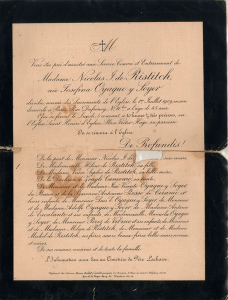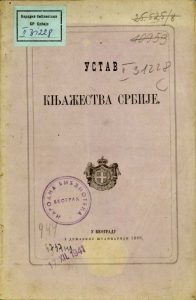THE REGENCY CONSTITUTION
The Constitution of Serbia of 1869 or The Regency Consitution was the third constitution of Serbia, which was in force from 1869 to 1888 and from 1894 to 1901.

The Regency Constitution was the first constitution adopted by the Serbian sovereign authorities and which did not need recognition by the Ottoman Empire. The Constitution got its name because it was passed by the Council of regency during the underage of Prince Milan Obrenović.
The Regency Constitution was the first constitution in Serbia to establish a representative system, adopt the principle of separation of powers, and recognize the basic personal and political rights of citizens. This constitution stipulates that elections in the country are public and indirect, and that the electoral threshold is high; that the legislative power is vested in the National Assembly, however, that the legislative initiative belongs to the prince, and that two-thirds of the officials are elected while one-third are appointed by the prince personally.
Since the Grand National Assembly, held in Topčider on June 20, 1868, approved the proclamation of a minor Milan Obrenović as Prince, he also appointed his council of regency: Milivoje Blaznavac, Jovan Ristić and Jovan Gavrilović.
Before the Constitutional Committee, also called „Nikoljski“ because the day Committee met, regency asked whether the country needed a constitution and what type of constitution should be adopted. It was decided that Serbia needed a new constitution; two-housed national representation; the introduction of ministerial responsibility and press freedom. There were also legal obstacles that needed to be remedied. Pursuant to the National Assembly Act of 1861 (Article 14 of the National Assembly Law), the Constitution cannot be amended during the prince is underaged, however the State Council, which was to decide to change the constitution, renounced that function in favor of the Grand National Assembly.
The constitution was adopted on June 19th, 1869 and is commonly referred to as the Regency Constitution or the Trinity Constitution
Conservatives have argued that the Constitution was enacted illegally and is too libertarian. Liberals were dissatisfied that the Constitution did not proclaim enough rights and freedoms. Although Serbia was still a vassal state at that time, the Ottoman Empire did not respond to the adoption of the Constitution.
The constitution of 1869 was reactionary in its content, even compared to the Turkish constitution of 1838 (amended in 1858). However, its “first life” lasted until 1888 when King Milan convened a constituent assembly that put together a new, more liberal constitution, which came into force in 1889.
After the attack on the State on April 1st 1893, King Aleksandar proclaimed the repeal of the Constitution of 1888 and reinstated the Constitution (1894) of 1869, which had been in force until a new Constitution was adopted by the Council of Ministers adopted on April 6th 1901.

